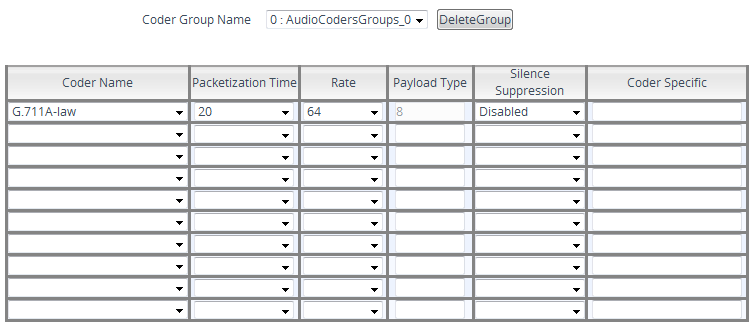Configuring Coder Groups
The Coder Groups table lets you configure up to
The Coder Groups table provides a pre-defined Coder Group (index 0) that is configured with the G.711 A-law coder. If no other Coder Groups are configured, the default Coder Group (which you can modify) is used for all calls. Alternatively, if you want to use specific coders or coder settings (e.g., packetization time) for different calls (entities), you need to configure a Coder Group for each entity and then assign each Coder Group to
| ● | For supported audio coders, see Supported Audio Coders. |
| ● | Some coders are license-based and are available only if included in the License Key installed on your device. For more information, contact the sales representative of your purchased device. |
| ● | Only the packetization time of the first coder listed in the Coder Group is declared in INVITE/200 OK SDP even if multiple coders are configured. The device always uses the packetization time requested by the remote side for sending RTP packets. If not specified, the packetization time is assigned the default value. |
| ● | The value of some fields is hard-coded according to common standards (e.g., payload type of G.711 U-law is always 0). |
| ● | The G.722 coder provides Packet Loss Concealment (PLC) capabilities, ensuring higher voice quality. |
| ● | Opus coder: |
| ✔ | For SBC calls: If one leg uses a narrowband coder (e.g., G.711) and the other leg uses the Opus coder, the device maintains the narrowband coder flavor by using the narrowband Opus coder. Alternatively, if one leg uses a wideband coder (e.g., G.722) and the other leg uses the Opus coder, the device maintains the wideband coder flavor by using the wideband Opus coder. |
| ✔ | Gateway calls always use the narrowband Opus coder. |
| ● | For more information on V.152 and implementation of T.38 and VBD coders, see Supporting V.152 Implementation. |
| ● | The G.729 coder refers to G.729A if silence suppression is disabled, or G.729AB if silence suppression is enabled. |
The following procedure describes how to configure the Coder Groups table through the Web interface. You can also configure it through ini file [AudioCodersGroups] and [AudioCoders], or CLI (configure voip > coders-and-profiles audio-coders-groups).
| ➢ | To configure a Coder Group: |
| 1. | Open the Coder Groups table (Setup menu > Signaling & Media tab > Coders & Profiles folder > Coder Groups). |

| 2. | From the 'Coder Group Name' drop-down list, select the desired Coder Group index number and name. |
| 3. | Configure the Coder Group according to the parameters described in the table below. |
| 4. | Click Apply, and then reset the device with a save-to-flash for your settings to take effect. |
You can delete a Coder Group, as described in the following procedure.
| ➢ | To delete a Coder Group: |
| 1. | From the 'Coder Group Name' drop-down list, select the Coder Group that you want to delete. |
| 2. | Click Delete Group. |
Coder Groups Table Parameter Descriptions
|
Parameter |
Description |
|||||||||||||||
|---|---|---|---|---|---|---|---|---|---|---|---|---|---|---|---|---|
|
'Coder Group Name' [AudioCodersGroups_Index] |
Defines the name and index for the Coder Group. Note: The Coder Group index/name cannot be configured. |
|||||||||||||||
|
[AudioCoders_AudioCodersIndex] |
Index row of the coder per Coder Group Note: The parameter is applicable only to the ini file. |
|||||||||||||||
|
'Coder Name' name [AudioCoders_Name] |
Defines the coder type. For coder names, see Supported Audio Coders. Note: Each coder type (e.g., G.729) can be configured only once in the table. |
|||||||||||||||
|
'Packetization Time' p-time [AudioCoders_pTime] |
Defines the packetization time (in msec) for the coder. The packetization time determines how many coder payloads are combined into a single RTP packet. For ptime, see Supported Audio Coders. |
|||||||||||||||
|
'Rate' rate [AudioCoders_rate] |
Defines the bit rate (in kbps) for the coder. For rates, see Supported Audio Coders. |
|||||||||||||||
|
'Payload Type' payload-type [AudioCoders_PayloadType] |
Defines the payload type if the payload type (i.e., format of the RTP payload) for the coder is dynamic. For payload types, see Supported Audio Coders. |
|||||||||||||||
|
'Silence Suppression' silence-suppression [AudioCoders_Sce] |
Enables silence suppression for the coder.
Note:
|
|||||||||||||||
|
'Coder Specific' coder-specific [AudioCoders_CoderSpecific] |
Defines additional settings specific to the coder. Currently, the parameter is applicable only to the AMR coder and is used to configure the payload format type.
Note: The AMR payload type can be configured globally using the AmrOctetAlignedEnable parameter. However, the Coder Group configuration overrides the global parameter. |